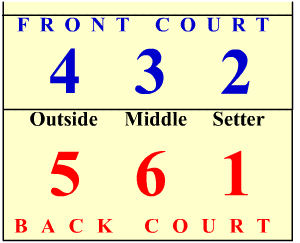VOLLEYBALL TAUNTON
| Switching Tutorial |
1. INTRODUCTION
Why do we 'switch' in volleyball?
Getting to the correct position after serving is a doddle, because you have
time to switch just after the ball has been served.
Getting to the right position whilst you are receiving service is harder, because
you has to see where the ball is going, play it if necessary, then move to the
right position, ever mindful that the opposition might chuck it back as you
are moving into position.
Below represents where and when you should be moving for different rotations.
When you played volleyball in school you probably played with 3 people in a
line in the front and 3 in the back.On change of service you rotated clockwise
but stayed where you were rotated to. There are several disadvantages with this
system:
- There are large areas of the court where the ball naturally goes that are not covered
- There is often confusion about whose ball it is because you are all in a line - especially with short balls between 2 players
- As you rotated, the kind of balls you received differed depending where you were, it seemed better if you could 'specialise" to one side of the court so you were used to it
- Similarly, setters are specialists, and you are always trying to dig or volley the first ball to them - it is best if you are always trying to dig/volley to the same place (normally front right of the court)
- Back court players cannot smash unless they take off behind the attack line (the line in the middle of court), which means that if the first ball went to the setter at the front court, you only effectively have 2 players who can whack it over the net. The system of switching means that both setters are always on the right side of the court, so that the backcourt setter can come forward and set to 3 front court players (see attacking)
To continue the discussion, we need to know a bit about the nomenclature of
positions :

There are 6 positions on the court - named 1 to 6. 1 is the server and the
rest are numbered sequentially round the court anticlockwise. The number refers
to position on court, not the player.
Positions 2,3 & 4 are front court players, 5,6 & 1 backcourt: to reiterate,
only front court players can smash at the net.
The right side of the court (1 & 2) is usually where the setters try to
end up: position 2 is the 'front court setter' and 1 the 'backcourt setter